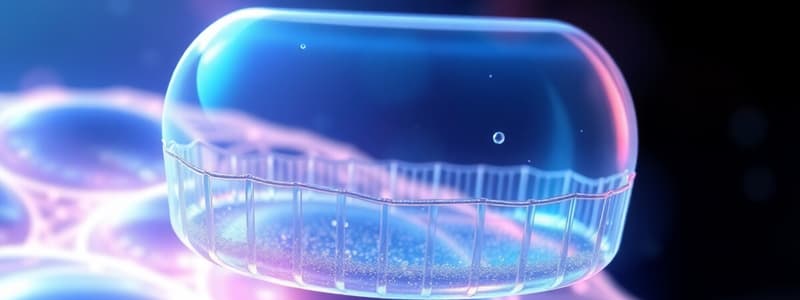Podcast
Questions and Answers
Which type of molecule primarily forms the boundary of the cell membrane?
Which type of molecule primarily forms the boundary of the cell membrane?
- Cholesterol
- Proteins
- Phospholipids (correct)
- Carbohydrates
What is the main purpose of cholesterol in the cell membrane?
What is the main purpose of cholesterol in the cell membrane?
- To signal other cells
- To keep the membrane fluid (correct)
- To provide energy storage
- To transport materials
Which statement best describes the term 'selectively permeable' as it relates to the cell membrane?
Which statement best describes the term 'selectively permeable' as it relates to the cell membrane?
- It is completely impermeable to water.
- It only allows gases to enter and leave.
- It selectively allows certain substances to pass. (correct)
- It allows all substances to pass freely.
What role do carbohydrates play in the cell membrane?
What role do carbohydrates play in the cell membrane?
What is the main function of proteins in the cell membrane?
What is the main function of proteins in the cell membrane?
What is the primary direction of movement for molecules during passive transport?
What is the primary direction of movement for molecules during passive transport?
Which of the following processes requires energy, such as ATP, to occur?
Which of the following processes requires energy, such as ATP, to occur?
In facilitated diffusion, what is essential for molecules to cross the plasma membrane?
In facilitated diffusion, what is essential for molecules to cross the plasma membrane?
Which type of transport specifically refers to the movement of water molecules?
Which type of transport specifically refers to the movement of water molecules?
What outcome is achieved when a solution reaches equilibrium?
What outcome is achieved when a solution reaches equilibrium?
What describes the movement of molecules during active transport?
What describes the movement of molecules during active transport?
Which of the following is NOT an example of passive transport?
Which of the following is NOT an example of passive transport?
What is the difference between diffusion and facilitated diffusion?
What is the difference between diffusion and facilitated diffusion?
Flashcards
Cell Membrane Function
Cell Membrane Function
The cell membrane controls what enters and leaves the cell.
Selectively Permeable
Selectively Permeable
The cell membrane allows certain substances to pass through but not others.
Phospholipid Bilayer
Phospholipid Bilayer
The cell membrane's main structural component, formed by two layers of phospholipids.
Hydrophilic Head
Hydrophilic Head
Signup and view all the flashcards
Hydrophobic Tail
Hydrophobic Tail
Signup and view all the flashcards
Protein Function (Membrane)
Protein Function (Membrane)
Signup and view all the flashcards
Carbohydrate Function (Membrane)
Carbohydrate Function (Membrane)
Signup and view all the flashcards
Cholesterol Function (Membrane)
Cholesterol Function (Membrane)
Signup and view all the flashcards
Passive Transport
Passive Transport
Signup and view all the flashcards
Active Transport
Active Transport
Signup and view all the flashcards
Concentration Gradient
Concentration Gradient
Signup and view all the flashcards
Diffusion
Diffusion
Signup and view all the flashcards
Facilitated Diffusion
Facilitated Diffusion
Signup and view all the flashcards
Osmosis
Osmosis
Signup and view all the flashcards
Equilibrium
Equilibrium
Signup and view all the flashcards
ATP
ATP
Signup and view all the flashcards
Study Notes
Cell Membrane Overview
- Cell membrane is also known as the plasma membrane.
- It is sometimes called the phospholipid bilayer.
Cell Membrane Composition
- Composed of phospholipids, proteins, and carbohydrates.
- Phospholipids are arranged in a bilayer with hydrophilic heads facing outward and hydrophobic tails facing inward.
Phospholipids
- Create the boundary of the cell membrane.
- Composed of two parts:
- Hydrophilic head (attracted to water)
- Hydrophobic tail (repelled by water, contains fatty acids)
- This arrangement creates a barrier that controls what moves in and out of the cell.
Proteins
- Help transport materials in and out of the cell.
- Various types of proteins exist embedded within the membrane.
- Channel proteins are always open to permit certain materials to passively move through the membrane.
- Carrier proteins help move materials across the membrane.
Carbohydrates
- Signal and identify particles outside the cell.
- Act like antenna for the cell.
Cholesterol
- Keeps the membrane fluid.
- Prevents lipids from sticking together.
Functions of the Cell Membrane
- Boundary: Acts as a flexible and fluid boundary, allowing the cell to change shape.
- Homeostasis: Helps maintain homeostasis by controlling what enters and leaves the cell. Transport materials in and out of the cell to maintain balance.
- Selectively Permeable: It only allows certain molecules to pass through easily (like water) while others (like sugars) can't pass through easily.
What Enters and Leaves the Cell
- Enter: Food, water, oxygen
- Leave: Waste, carbon dioxide
Studying That Suits You
Use AI to generate personalized quizzes and flashcards to suit your learning preferences.




